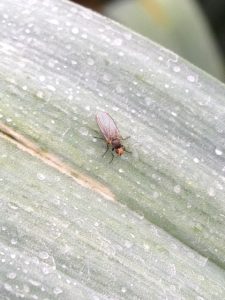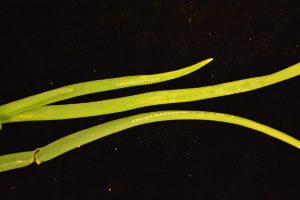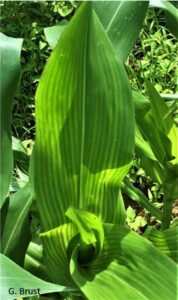Allium Leaf Miner (ALM)
Allium leaf miner feeding and egg laying injury was discovered on chives and garlic near Milford in Hunterdon County on Wednesday. All weather stations on the NEWA network except for a few in the highest elevation sites in northern New Jersey have surpassed 250 growing degree days (GDD) base 39˚F. 39˚F is close to the lower developmental temperature (38.3˚ F) which our colleagues at Penn State recommend for predicting the first emergence of ALM adults. In recent years, initial feeding/egg laying scars have been detected within a few days of local weather stations recording the 250 GDD threshold. Growers who feel they may be impacted by this pest should check the accumulated GDD from local weather stations. Growers in southern counties may reasonably assume there will be ALM activity in their area soon, if not already happening. To determine GDD from local weather stations, the NEWA website https://newa.cornell.edu/ is very helpful. From the NEWA home screen, select the nearest weather station from drop down menu at the center of the page. Next, scroll down to “Weather Tools” on the right side of the page, and select “DD Calculator”. Select your start date (1/01/23) and end date as well as Degree Day Type (39 F) from the menu at the left of the page. The site will automatically generate the accumulated GDD base 39F to the last day of your requested sample, and then offer a forecast of accumulated GDD for the next week.
Growers should consider initiating the control method of their choice at this time. Affected crops include chives, scallions, garlic, onions and leeks. Look for neat rows of white spots descending from the upper tips of allium leaves (see photo at left). Initial injury often occurs on the tallest leaves. Under warmer, less breezy conditions, adults may be seen near the tips of leaves (see photo of adult at lower right). Perennial chive beds are often the first, and most heavily infested alliums of the spring season, so this makes chives an ideal crop to confirm ALM adult activity. At the Milford site this week, chives had feeding/egg laying scars on nearly 30% of leaves. The garlic field, which was approximately a half mile away, exhibited only 2% infested plants. A primary reason for this lower infestation rate in the garlic is that allium crops had not been grown in that field for several years.
Floating row covers, kept on until this flight ends will help minimize access to plants. Insecticide applications targeting adults may be helpful as well, although frequency of applications is uncertain. Spinosyn materials (Radiant, Entrust (OMRI approved)), pyrethroids (Mustang Maxx,  Warrior), neonicotinoids (Scorpion, Venom), the diamide Exirel (section 2ee recommendation) and the insect growth regulator Trigard are labeled for miner control.
Warrior), neonicotinoids (Scorpion, Venom), the diamide Exirel (section 2ee recommendation) and the insect growth regulator Trigard are labeled for miner control.
Adult activity and observations of feeding will be reported on in the IPM Update as they occur.
 Articles in this section contain information helpful to the NJ commercial organic grower.
Articles in this section contain information helpful to the NJ commercial organic grower.


